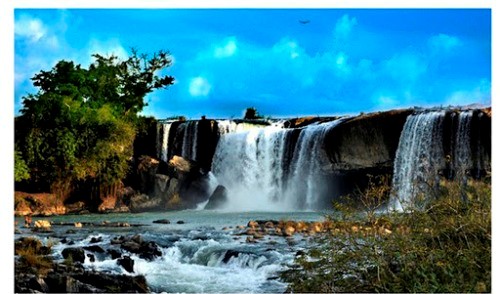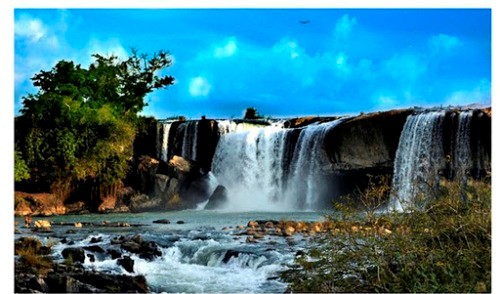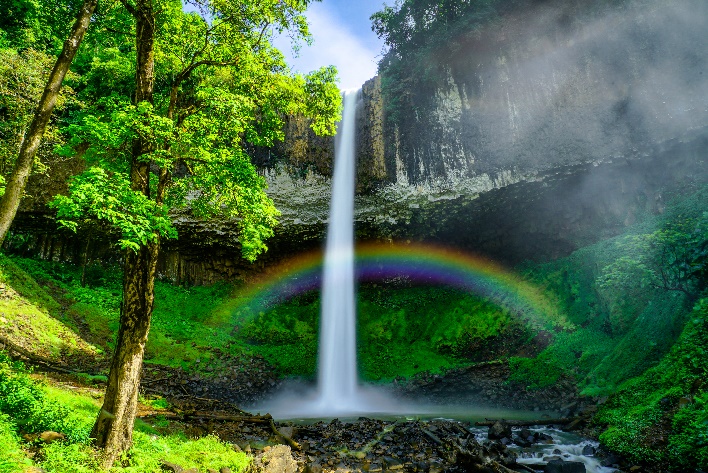
Dak Nong Geopark was established in 2015 with an area of 4,760km2. Its boundary stretches over five districts of Krong No, Cu Jut, Dak Mil, Dak Song, Dak G'long and Gia Nghia city. Owning the unique heritage values of international level, Dak Nong Geopark was officially designated as a UNESCO Global Geopark in July 2020 by the 209th UNESCO Executive Council.
Being a noble designation of UNESCO, a "Geopark" performs its mission to contain and link all types of heritage values, such as: geology, culture, history, nature, landscape, biodiversity, etc. Besides the goal of heritage preserving and promoting, educating and raising public awareness on Earth science, a UNESCO Global Geopark also sets out a comprehensible goal of improving community life as well as promoting local socio-economic development in a sustainable way through tourism activities.

Dak Nong UNESCO Global Geopark aims to develop its economy through sustainable tourism activities
Having just been a UNESCO Global Geopark since 2020, however, Dak Nong Geopark had made its reputation long before that for its most massive and longest volcanic cave system in Southeast Asia, together with its 44 heritage sites, which works as a catalyst for tourists and potential investors to promote local socio-economic development.
Following are some obvious opportunities that the designation of a "UNESCO Global Geopark" brings to Dak Nong Province:
1. Developing economy through sustainable tourism
The clearest evidence is the increasing number of projects on tourism – service sector over the period of time. Particularly, there are some promising investment projects, such as: The Resort and Heart-Understanding Meditation Project in Nam Nung Nature Reserve (Heart-Understanding Tourism Joint Stock Company), Dak R'Tih Lake Ecotourism Urban Area (T&T Group Joint Stock Company), etc. In addition, Ta Dung Investment and Development Joint Stock Company has been proposing to Dak Nong provincial authority to approve some projects such as: Dak Nia Ecological Urban Area, Lieng Nung Resort, Ta Dung Tourism complex with a total investment up to 9.5 trillion VND.
Moreover, the province has witnessed the steady increase in the number of tourists over the years, from 17,000 arrivals (2014) to 385,000 arrivals (2019). Its image and people has also gradually got attention from domestic and foreign media thanks to the development of Dak Nong UNESCO Global Geopark (Dak Nong UGGp).
Most importantly, the province has decided to further boost sustainable tourism - service industry in parallel with mining and mineral processing industry. This policy is proven through the establishment of a large territory of Dak Nong Geopark to preserve and promote special local tourism resources for tourism activities.
2. Opening up new livelihood opportunities
As a place to nurture and promote local culture, Dak Nong UGGp brings a chance to revive a number of traditional crafts of the indigenous people, such as knitting, brocade weaving, tube-wine making, etc. Moreover, with Dak Nong UGGp's "Certificate of Partner's Product", typical local products such as coffee, pepper, macadamia, avocado, turmeric, etc. will gain more value on international market.
On the other hand, geo-tourism will be a major contributor to employment creation particularly for women, youth, rural communities and indigenous peoples in near future as it has numerous linkages with other sectors. As a consequence, tourism industry can lead to the local reduction of poverty and to the promotion of provincial socio-economic development.
3. Strengthening international integration to promote the provincial tourism industry
The recognition of UNESCO Global Geopark is not only significant for Dak Nong province, but also a great honor for Vietnam, which creates favorable conditions to globally promote the image of Vietnam in general and Dak Nong province in particular.
In the trend of international integration, Dak Nong province will have more competitive advantages when becoming one of 169 geopark-members of 44 countries in the Global Geopark Network. With a variety of the networking activities such as: conference, fairs, training courses, contests, etc., Dak Nong will have a chance to consolidate its international cooperation and globally promote its tourism image.
4. Raising public awareness on environmental issues
This is one of the most important goals of a UNESCO global geopark. Thus, over the past years, Dak Nong UGGp periodically organized propaganda activities for local people, especially for students, to understand and be more proud of heritage values on their land.
The propaganda activities on Dak Nong's heritage values are very diverse, not only through traditional media (radio, newspapers, magazines, leaflets, panels, handbooks, etc.), but also through social networks such as website, facebook, etc in addition to some formal forms of trainings, field trips and contests. Thereby, the heritage values of Dak Nong Geopark are more and more widely disseminated, contributing to raising the community's responsibility in heritage conservation.
Not only that, Dak Nong authority has implemented many research projects to mitigate the consequences of geological hazards such as flash floods, landslides, risk of soil erosion, drought and other manifestations of climate change. Also, they focus on educating and guiding people to practice environmentally friendly initiatives, contributing to improving the quality of the local living environment and tourism space.
5. Preserving and promoting overall heritage values to form a unique local tourism space
One of the most obvious benefit during the formation and development of the geopark is the discovery of many valuable geological heritages and related indigenous knowledge about those sites. From craters, lava-tube cave system, geosites to the site interpretation in perspective of indigenous polytheism, altogether they create a colorful cultural painting which forms a premise to flourish local tourism.
Notably, before the local geological heritage was investigated, the provincial authority had allowed a private company to exploit production of pozzolanic cement in Nam Kar volcanic area. However, thanks to scientists' recommendations, this mining activity was made to stop in order to preserve a precious geosite for future generations.
Soon after that, the province issued some new regulations on the protection of geological heritage sites. Moreover, the authority also becomes more cautious in choosing potential and responsible investors for tourism exploitation. For example, though 50 caves have been investigated and researched so far, Dak Nong auhority has only allowed the exploitation of tourism activities in just one cave (C3) under strict safety conditions. This clarifies the fact that local geoheritage nowadays has received more attention than ever before.
Futhermore, as "The Land of Sounds", Dak Nong UGGp has designed three featured routes (The Rhapsody of Fire and Water, the Wind of Change Concerto and Sounds from the Earth) to link and add more value to its heritage sites in order to create unforgettable experiences for tourists on visiting this land.
However, the province is still facing many difficulties and challenges…
It is clear that the title of "Dak Nong UNESCO Global Geopark" has contributed to consolidating the domestic and international position of Dak Nong province. To get this noble designation, the province has paid a great efforts. However, to maintain this after UNESCO's revalidations is even more difficult. For that, Dak Nong province need to address difficulties and challenges that its geopark is facing.
Firstly, the term "UNESCO Global Geopark" is difficult for many people to understand as it is a quite new definition to most Vietnamese. Furthermore, geotourism is also a new form of tourism, targeting at a niche market so it is not easy for everyone to see the beauty and uniqueness of sites within the geopark.
On the other hand, though Dak Nong province is blessing with many scenic scenes, they are quite small and scattered. Thus, to add more value to these sites, Dak Nong province needs to brainstorm on creating unique specific tourism products featured by the geopark.
Secondly, aiming to develop geotourism, the province's tourism resources, mainly geological heritages, is vulnerable of being damaged or lost due to erosion in rainy season. What is more, most geosites are located in the areas of traditional agricultural cultivation. Unless local people are aware of their heritage treasure, it is hard to keep these heritage encroachment-free.
In addition, Dak Nong province currently has 20 hydropower projects, which have been licensed and operated before the geopark's establishment. In addition to a number of benefits like generating electricity, creating water reservoirs, they also more or less affect downstream areas negatively, including water volume of the waterfalls within the geopark. Though some measurements such as reforestation, reasonable operation of hydropower plants, etc., have been carried out, this has sill more or less affected the tourism resources of the province.

Lieng Nung Waterfall in Dak Nong UNESCO Global Geopark. Photo: Vo Anh Tu
Thirdly, with the designation of a "UNESCO Global Geopark", Dak Nong province will become a new attractive destination. However, at the same time, it has to face a severe competition with other well-known tourist cities of Ho Chi Minh, Da Lat (Lam Dong province), Buon Ma Thuot (Dak Lak province) and Phan Thiet (Binh Thuan province) which have better infrastructure with domestic or international airports and experience in tourism industry.
Therefore, promoting local tourism industry based on Dak Nong UGGp's unique characteristics such as volcanos, lava-tube caves, etc., is the essential key for the province to make its mark on the tourism map of Vietnam.
Bach Van